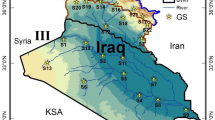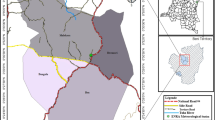Abstract
Using surface and NCEP reanalysis data along with radar and satellite images, diagnosis has been carried out to probe the reasons for the very heavy rainfall that occurred in Islāmābad-Rāwalpindi on 23 July 2001. It has been revealed that the sudden evolution of this meso-scale severe weather system was the direct result of strong surface convection in moist and unstable lower layers of the atmosphere. The subsequent rapid development was the combined effect of the presence of the mid latitude westerly’s trough in the north and moisture feeding through monsoon flow along the Himalayas and also the direct south-westerly current from the Arabian Sea. After the westward shifting of the Sub-Tropical High (STH) from the north of India, the strong divergence zone on its eastern edge contributed positively to the development of upward motion. Initially the convective systems moved towards the south and then southeastward following the steering current in the middle troposphere. Based on these analyses, the physical model of the sudden record heavy rainfall has been proposed and a comparison between the heavy rainfall in this case and one in China has been conducted.
Similar content being viewed by others
References
Ailikun, B. and T. Yasunari, 2001: ENSO and summer monsoon; persistence and transitivity in the seasonal march.J. Meteor. Soc. Japan,79(1), 145–159.
Bei, N. F., S. X. Zhao, and S. T. Gao, 2002: Numerical simulation of a heavy rainfall event in China during July 1998.Meteorol. Atmos. Phys.,80, 153–164.
Chaudhry, Q. Z., 1991: Analysis and seasonal prediction of Pakistan Summer Monsoon. Ph. D. dissertation, University of Philippines, 1–215.
Ding Yihui, Fu Xiuqin, and Zhang Baoyan, 1984: Study of the structure of a monsoon depression over the Bay of Bengal during summer MONEX.Adv. Atmos. Sci.,1(1), 62–75.
Kar, S. C., M. Sugi, and N. Sato, 2001: Interannual variability of Indian summer monsoon and internal variability in the JMA global model simulations.J. Meteor. Soc. Japan,79(2), 607–623.
Krishnamurti, T. N., 1971: Observational study of the tropical upper tropospheric motion field during the northern hemispheric summer.J. Appl. Meteor.,10, 1066–1096.
Krishnamurti, T. N., and T. Murakami, 1981: On the onset vortex of the summer Monsoon.Mon. Wea. Rev.,109, 344–363.
Ma Henian, and Ding Yihui, 1997: The present status and future of research of the East Asian Monsoon.Adv. Atmos. Sci.,14(2), 125–140.
Murakami, T., and Y. H. Ding, 1982: Wind and temperature changes over Eurasia during the early summer of 1979.J. Meteor. Soc. Japan.,60, 183–196.
Ohsawa, T., H. Ueda, and T. Hayashi, 2001: Diurnal variations of convective activity and rainfall in tropical Asia.J. Meteor. Soc. Japan,79(1B), 333–352.
Pankistan Meteorological Department, 1994: Climate Normals (1961–90) of Pakistan, Islāmābad-Pakistan, 1–80.
Pearce, R. P., and U. C. Montanty, 1984: Onset of the Asian summer monsoon 1979–1982.J. Atmos. Sci.,41, 1620–1639.
Ramage, C. S., 1971:Monsoon Meteorology. Academic Press, 1–296.
Rao, Y. P., V. Srinivasan, and S. Raman, 1970: Effect of middle latitude westerly systems on Indian Monsoon.Syp. Trop. Met. Hawaii. N, IV 1–4.
Rao, Y. P., 1976:Southwest Monsoon. Meteor. Monogr. (Synoptic Meteorology), No. 1, India Meteorological Dempartment, New Delhi, 367pp.
Tao Shiyan, 1980: Rainstorm in China, Scientific Press, Beijing, 1–225.
Tao Shiyan, and Chen Longxun, 1988: A review of recent research on the East Asian Summer Monsoon in China.Monsoon Meteorology, Oxford University Press, 60–92.
Zhang Feng, and Zhao Sixiong, 2004: A Study of formation and development of one kind of cyclone on the Mei-yu (Baiu) Front.Adv. Atmos. Sci.,21(5), 741–754.
Zeng, Q. C., B. L. Zhang, Y. L. Liang, and S. X. Zhao, 1994: East Asia Summer Monsoon-a case study.Proc. Indian Nat. Sci. Acad.,60a(100), 81–96.
Zhao Sixiong, 1988: Energetics of cyclogenesis on Meiyu (Baiu) Front.Proc Palmen Memorial Symposium on Extratropical Cyclones, Helsinki, Finland, 205–208.
Zhao Sixiong, and G. A. Mills, 1991: A study of a monsoon depression bringing record heavy rainfall over Australia. Part II; Synoptic-Diagnostic description.Mon. Wea. Rev.,119(9), 2074–2094.
Zhao Sixiong, Bei Naifang, Sun Jianhua, Chen Hong, Zhang Feng, and Qi Lixin, 2002: A study of heavy rainfall systems in mid-lower latitude zone of AsianAustralian Monsoon Area.Climatic and Environmental Research,7(4), 377–385. (in Chinese)
Author information
Authors and Affiliations
Corresponding author
Rights and permissions
About this article
Cite this article
Rasul, G., Chaudhry, QuZ., Sixiong, Z. et al. A diagnostic study of record heavy rain in twin cities Islāmābad-Rāwalpindi. Adv. Atmos. Sci. 21, 976–988 (2004). https://doi.org/10.1007/BF02915599
Received:
Revised:
Issue Date:
DOI: https://doi.org/10.1007/BF02915599




